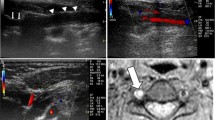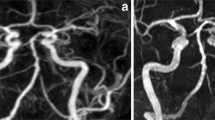Abstract
We aimed to investigate the utility of the isoFSE sequence, one of the variable flip angle 3D fast-spin echo sequences, on 3T-MR for displaying vessel walls and diagnosing vertebrobasilar artery dissection (VAD). We retrospectively evaluated 12 initial and 28 follow-up images from 12 patients diagnosed with either intracranial VAD or carotid artery dissection. The image quality for displaying the vessel wall was scored using a five-point scale (1 poor, 5 excellent) on initial T1-weighted isoFSE images for each region of the arteries. The intracranial artery dissection findings assessed at time points after onset were evaluated on initial and follow-up T1/T2-weighted isoFSE images. For small arteries, including the anterior/posterior inferior cerebellar artery, similar high scores were obtained on both unenhanced and contrast-enhanced T1-weighted isoFSE images (average: 4.7–5.0, p > 0.2). On unenhanced images, dissected vertebral arteries showed significantly lower scores than non-dissected vertebral arteries for both readers (p = 0.017 and 0.015, respectively), but the scores were high (3.9 and 4.0, respectively). Definitive findings of VAD were observed on the initial images except in one case. For all cases, definitive findings were seen on at least one of the initial or follow-up images. Temporal changes in the findings could be observed for all cases. In conclusion, we showed favorable wall visualization on T1-weighted isoFSE images and the utility of follow-up imaging using unenhanced-T1/T2-weighted and contrast-enhanced T1-weighted isoFSE sequences with acceptable scan times, which could promote the regular use of 3D black-blood vessel wall imaging.


Similar content being viewed by others
References
Lum C, Chakraborty S, Schlossmacher M, Santos M, Mohan R, Sinclair J, et al. Vertebral artery dissection with a normal-appearing lumen at multisection CT angiography: the importance of identifying wall hematoma. AJNR Am J Neuroradiol. 2009;30(4):787 – 92.
Sakurai K, Miura T, Sagisaka T, Hattori M, Matsukawa N, Mase M, et al. Evaluation of luminal and vessel wall abnormalities in subacute and other stages of intracranial vertebrobasilar artery dissections using the volume isotropic turbo-spin-echo acquisition (VISTA) sequence: a preliminary study. J Neuroradiol. 2013;40(1):19–28.
Ishitsuka K, Sakaki Y, Sakai S, Uwatoko T, Aibe H, Ago T, et al. Diagnosis and follow-up of posterior inferior cerebellar artery dissection complicated with ischemic stroke assisted by T1-VISTA: a report of two cases. BMC Neurol. 2016;16:121.
Takemoto K, Takano K, Abe H, Okawa M, Iwaasa M, Higashi T, et al. The new MRI modalities “BPAS and VISTA” for the diagnosis of VA dissection. Acta Neurochir Suppl. 2011;112:59–65.
Hosoya T, Adachi M, Yamaguchi K, Haku T, Kayama T, Kato T. Clinical and neuroradiological features of intracranial vertebrobasilar artery dissection. Stroke. 1999;30(5):1083–90.
Edjlali M, Roca P, Rabrait C, Naggara O, Oppenheim C. 3D fast spin-echo T1 black-blood imaging for the diagnosis of cervical artery dissection. AJNR Am J Neuroradiol. 2013;34(9):E103-6.
Koga H, Oishi T. 3.0T MR Imaging of the Cranial Arterial Wall for the Strategy of Stroke Prevention. Neuroradiol J. 2011;24(1):101 – 14.
Li ML, Xu YY, Hou B, Sun ZY, Zhou HL, Jin ZY, et al. High-resolution intracranial vessel wall imaging using 3D CUBE T1 weighted sequence. Eur J Radiol. 2016;85(4):803–7.
Zhang L, Zhang N, Wu J, Zhang L, Huang Y, Liu X, et al. High resolution three dimensional intracranial arterial wall imaging at 3 T using T1 weighted SPACE. Magn Reson Imaging. 2015;33(9):1026–34.
Kitanaka C, Tanaka J, Kuwahara M, Teraoka A. Magnetic resonance imaging study of intracranial vertebrobasilar artery dissections. Stroke. 1994;25(3):571–5.
Takano K, Yamashita S, Takemoto K, Inoue T, Kuwabara Y, Yoshimitsu K. MRI of intracranial vertebral artery dissection: evaluation of intramural haematoma using a black blood, variable-flip-angle 3D turbo spin-echo sequence. Neuroradiology. 2013;55(7):845 – 51.
Abe T. Fast fat suppression RF pulse train with insensitivity to B1 inhomogeneity for body imaging. Magn Reson Med. 2012;67(2):464–9.
Hoksbergen AW, Fulesdi B, Legemate DA, Csiba L. Collateral configuration of the circle of Willis: transcranial color-coded duplex ultrasonography and comparison with postmortem anatomy. Stroke. 2000;31(6):1346–51.
Nagao E, Yoshiura T, Hiwatashi A, Obara M, Yamashita K, Kamano H, et al. 3D turbo spin-echo sequence with motion-sensitized driven-equilibrium preparation for detection of brain metastases on 3T MR imaging. AJNR Am J Neuroradiol. 2011;32(4):664 – 70.
Wang J, Yarnykh VL, Yuan C. Enhanced image quality in black-blood MRI using the improved motion-sensitized driven-equilibrium (iMSDE) sequence. J Magn Reson Imaging. 2010;31(5):1256–63.
Qiao Y, Zeiler SR, Mirbagheri S, Leigh R, Urrutia V, Wityk R, et al. Intracranial plaque enhancement in patients with cerebrovascular events on high-spatial-resolution MR images. Radiology. 2014;271(2):534 – 42.
Madokoro Y, Sakurai K, Kato D, Kondo Y, Oomura M, Matsukawa N. Utility of T1- and T2-weighted high-resolution vessel wall imaging for the diagnosis and follow up of isolated posterior inferior cerebellar artery dissection with ischemic stroke: report of 4 cases and review of the literature. J Stroke Cerebrovasc Dis. 2017;26(11):2645–51.
Luo Y, Guo ZN, Niu PP, Liu Y, Zhou HW, Jin H, et al. 3D T1-weighted black blood sequence at 3.0 T for the diagnosis of cervical artery dissection. Stroke Vasc Neurol. 2016;1(3):140–6.
Funding
No outside source of funding was received for this study.
Author information
Authors and Affiliations
Corresponding author
Ethics declarations
Conflict of interest
The authors declare that they have no conflicts of interest.
Ethical statement
All procedures in this study were performed in accordance with the ethical standards of our institutional research board and with the 1964 Declaration of Helsinki.
This study did not contain experiments on human or animal participants.
Informed consent
Informed consent was waived in this retrospective study.
About this article
Cite this article
Ogawa, M., Omata, S., Kan, H. et al. Utility of the variable flip angle 3D fast-spin echo (isoFSE) sequence on 3T MR for diagnosing vertebrobasilar artery dissection. Radiol Phys Technol 11, 228–234 (2018). https://doi.org/10.1007/s12194-018-0460-7
Received:
Revised:
Accepted:
Published:
Issue Date:
DOI: https://doi.org/10.1007/s12194-018-0460-7




